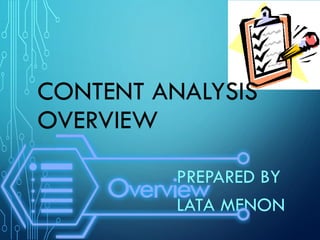
Overview of content analysis
- 2. INDEX • Meaning & Definitions • Units of Communication • Reference Units • Categorization of content • Steps of content analysis • Importance of content analysis • Limitations of content analysis • Suggestions to use Content analysis effectively • Research Problems for content analysis
- 3. 1. MEANING & DEFINITION Analysing the content in order to study it scientifically can be termed as Content Analysis. The content is analysed logically, deeply, systematically, and in an objective and scientific manner in order to clarify its intention and meaning to describe it.
- 4. content analysis is a research technique for the objective, systematic, and quantitative description of the manifest content of communication. - Berelson any technique for making inferences by systematically and objectively identifying specified characteristics of message - Holsti content analysis is a method of studying and analyzing communication in a systematic, objective, and quantitative manner for the purpose of measuring variables. - Kerlinger
- 5. SOURCES OF CONTENT ANALYSIS • Verbal Printed Material- Newspapers, Journals, Periodicals, Government Documents • Verbal Written Material- Letters, Diaries, Personal Calendar, Annual Accounts • Verbal Oral Material- Lectures, Speech, Radio Programmes, Audio-CD, Debates • Visual Material- Drawings, Paintings, Diagram, Sketch, Photograph • Audio Visual Material- Cinema, Television Programmes, News, Drama, Roleplay etc
- 6. UNITS OF COMMUNICATION A unit is the smallest part of communication material which is used to derive content analysis. Such units maybe in a form of: • Letter, Word, Phrase, Concept, Statement, • Sentence, Theme, Paragraph, Shloka-Stanza, etc. • Time and space can also be considered as a unit for respective sources
- 7. RECORDING UNITS A part of communication from which clear facts or thoughts can be obtained and can be recorded and counted easily is called a recording unit. Some of such types of recording units can be derived by asking questions such as: How many times a particular word appears a content, how many words are associated with a particular concept or meaning. How many sentences are associated with a particular thought How many articles are written in that theme How many symbols are used, what do they indicate How many programmes have been telecasted on particular theme on Television For Every unit relevant questions have to be asked about the occurrence of those units
- 8. REFERENCE UNITS The unit that contains 2 or more recording units is called a reference unit. Reference unit is a relative concept. A unit can be considered as reference unit in one research and a recording unit in other. For E.g. In the study of number of religious article in a particular periodical, religious article Will be considered as a recording unit , But in the study that is focussed on values emerging From religious article, the religious article will be considered as reference unit.
- 9. CATEGORIZATION OF CONTENT Content is divided into different categories according to the objectives of research. It is found in categories. For e.g.: the following categories can be decided in the study of “Educational news published in newspapers” News related to primary education News related to Secondary education News related higher secondary education News related to Higher education Miscellaneous educational news Furthermore categories can be created related to examination system, number of schools, facilities etc. Here News is a reference unit
- 10. STEPS OF CONTENT ANALYSIS • Selection of the area of research • Selection of a problem • Formation of the Objective • Formation of research questions or Hypothesis • Selection of sample • Defining units of analysis • Deciding categories for units of analysis • Preparation of record schedule • Derivation of units of analysis • Categorization and analysis of units- Manifest Meaning/Latent Meaning • Derivation of finding • Report writing
- 11. IMPORTANCE/UTILITY OF CONTENT ANALYSIS • Any subject can be studied in detail by collecting communication details from different sources • Communication units can be studied deeply • Insight for understanding the content in the right context can be developed • Large qualitative information can be quantified and condensed in limited area • Researcher doesn’t have to contact a person to collect data • Different communication based on the same theme can be compared properly
- 12. LIMITATIONS OF CONTENT ANALYSIS • Sometimes the researcher has to refer a large communication material for obtaining the required material • Reliability of such study cannot be established in an objective way • Collection, analysis and interpretation can be affected by the bias of a researcher • If care is not taken while deriving the meaning from the content in a right context, reliable findings cannot be derived • New and unexperienced researcher cannot use this method effectively, because it needs good insight and reasoning ability to derive the meaning from communication unit • Deep study of communication material requires more time
- 13. SUGGESTIONS TO USE CONTENT ANALYSIS EFFECTIVELY • Communication material should be studied deeply with reasoning • Intensive efforts should be made to derive latent meaning of the words in right context • The researcher should have good command on language • Categories, made for recording units should be mutually exclusive • Communication material should be scanned roughly before deciding the categories of units by keeping in mind the objectives of research
- 14. RESEARCH PROBLEMS FOR CONTENT ANALYSIS • Values emerging from a particular book • Values emerging from a television/serial/textbook/poem/story/novel • Educational thought emerging from television serial/textbook/poem/novel • Educational thoughts of Gandhiji/Vivekananda • Comparative study of textbooks of the same subject of different states • Study of court judgements given on educational disputes • Philosophy of Vivekananda regarding the life of youth
- 15. THANK YOU